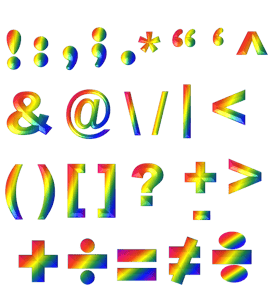
The SAT Reading and Writing section will test you on your knowledge of punctuation. Understandably, many students are utterly confused by commas and semicolons and clueless when it comes to colons and dashes.
In this article, I'll eliminate your confusion and explain all of the punctuation rules you need to know to ace SAT Reading and Writing. Furthermore, I'll provide practice questions to test you on what you've learned.
Punctuation on SAT Reading and Writing
SAT punctuation questions—which are included in the ‘Standard English Conventions’ category of SAT Reading and Writing—test you on your knowledge of commas, semicolons, colons, dashes, and apostrophes. There are two separate content areas that are tested within the Standard English Conventions category of the digital SAT: 1) boundaries and 2) form, structure, and sense. The boundaries questions will test your knowledge on punctuation (get it: because we use punctuation to mark the boundaries of phrases, clauses, and sentences!).
In this article, I’ll explain the rules for all punctuation except apostrophes because I’ve devoted a separate article to apostrophes. There are around 11-15 Standard English Convention questions on SAT Reading and Writing, and you can expect about half of those to test your knowledge of punctuation.
Most of the punctuation rules are fairly straightforward; if you spend the time to learn and understand these rules, you should be able to correctly answer the punctuation questions on SAT Reading and Writing.
The Rule for All SAT Punctuation Questions: When in Doubt, Leave It Out
For the SAT, if you’re unsure if a sentence requires punctuation, it’s better to err on the side of leaving out punctuation. Only use commas, semicolons, colons, or dashes if you identify a situation that requires them. You’re more likely to miss a punctuation question by adding unnecessary punctuation than by leaving out punctuation that’s needed. Take a look at this example:

The comma after “Gingerbread” is unnecessary. A common error on SAT punctuation questions is to randomly place a comma or semicolon within a sentence, especially in sentences in which there are other commas. In this sentence, answer choice C is the correct answer. No punctuation is needed. Remember that if punctuation isn’t needed, you should leave it out if you’re given the option.
Now I’ll go over specific rules to help you determine when to use punctuation.
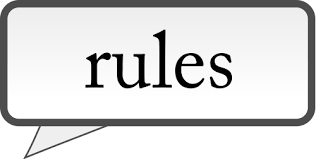
The 6 SAT Comma Rules
While there are a multitude of comma rules, the SAT only tests a few of them. I’ll explain the comma rules that are important to know for the SAT.
#1: Surround Non-Restrictive Clauses and Appositives With Commas
The key rule to remember here is that a portion of a sentence that can be removed without changing the meaning of the sentence must be surrounded by commas.
Relative Clauses: Restrictive vs. Non-Restrictive
Relative clauses are dependent clauses that describe a noun and start with a relative pronoun or adverb like “who,” “that,” “which,” or “where.” The basic rule is that restrictive clauses shouldn’t be surrounded by commas and non-restrictive clauses should be.
What’s a Restrictive Clause?
Restrictive clauses are essential to the meaning of the sentence. You can’t take a restrictive clause out of a sentence without significantly changing the meaning of the sentence. Here’s an example:
People who sleep well are more alert.
If you remove the clause “who sleep well,” the meaning of the sentence would be substantially changed. You’d be left with “People are more alert.” Because you can’t remove the clause without changing the meaning of the sentence, the clause shouldn’t be surrounded by commas.
What’s a Non-Restrictive Clause?
A non-restrictive clause isn’t essential to the meaning of the sentence. If you got rid of the clause, the sentence would still make sense, and its meaning wouldn’t change. Here’s an example sentence with the non-restrictive clause underlined.
Nate, who works as a software engineer, majored in computer science.
The clause “who works as a software engineer” adds more information about Nate, but if it were removed, the meaning of the sentence would be the same. There would be less information about Nate, but the sentence still states that he majored in computer science. This is what the sentence looks like after removing the non-restrictive clause:
Nate majored in computer science.

What Is an Appositive?
An appositive is a descriptive phrase that doesn’t include a verb. Like a non-restrictive clause, an appositive can be removed without changing the meaning of the sentence. Here’s an example sentence with the appositive underlined:
Torsha, a fan of celebrity gossip, loves watching The Wendy Williams Show.
If we get rid of the appositive, the sentence still has the same meaning:
Torsha loves watching The Wendy Williams Show.
If you’re unsure if a phrase is an appositive, eliminate the phrase. If the meaning of the sentence is unchanged, the descriptive phrase is an appositive that should be surrounded by commas.
The rule that appositives must be surrounded by commas is one of the most often tested comma rules on the SAT.
SAT Example

We’ll work through process of elimination with this example. Answer choice A doesn’t work because in order to use a semicolon there must be independent clauses (complete sentences) on both sides, and the clause beginning with “producing” can’t stand on its own. For that same reason, we can also eliminate answer choice B—splitting the sentence in two with a period would leave us with an incomplete sentence (a sentence fragment) beginning with “producing.”
Answer choice C might be the most confusing choice of all, because without any punctuation it’s difficult to know that “the study of fungi” is a non-restrictive clause that’s giving us a little more information about what mycology is. Without any punctuation, the sentence just seems to run on and on and is difficult to navigate. The correct answer choice is D, because it encloses “the study of fungi” within two commas, effectively separating a non-restrictive clause from the rest of the sentence. We could remove that clause completely and the main point of the sentence would stay the same, so we know that’s what makes it non-restrictive.
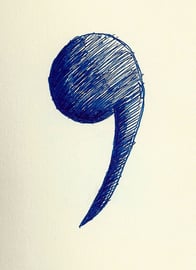
Pretty comma (stealingsand/Flickr)
#2: Use Commas After Introductory Phrases or Clauses
Any time a sentence starts with a dependent clause or modifying phrase, it must be followed by a comma. Here are some examples:
Although I want to go to Hawaii for Joe’s wedding, I have to work.
In high school, Suzy was the class clown.
Unable to focus because of the loud construction work outside, Harry went to the library to study.
SAT Example
On the SAT, a sentence may include an introductory dependent clause or phrase, and you have to select the proper punctuation that follows the introduction. Only a comma can come after an introductory phrase or clause that isn’t a complete thought.


When an introductory phrase describes a noun, the noun being modified must come directly after the comma. In this sentence, the introductory phrase from “A conceptual” to “fashion” is modifying Mary Ping. Because the phrase isn’t a complete thought, meaning it can’t stand alone as a sentence, we must put a comma at the end of the phrase. The correct answer is D.
#3: Use Commas to Separate Items in a List
You’re probably familiar with this comma rule: in lists of three or more items, you must place a comma after every item except the last. Check out this example:
During spring break, my days will consist of eating, watching Netflix, and sleeping.
The three items on the list are “eating,” “watching Netflix,” and sleeping. Because there are three items, there are commas after the first two. The last comma in the list before “and,” known as the oxford comma, is technically optional, and you won’t be tested on whether or not to use it. However, every list question I've seen uses the oxford comma.
Here’s another example:
Participation in sports teaches many important values, including perseverance, teamwork, and dedication.
The three items on this list are “perseverance,” “teamwork,” and “dedication.” On the SAT, there may be incorrectly placed commas placed before the first item or after the “and” prior to the last item. In the sentence above, you can’t place a comma after “including” or before “dedication.”
Incorrect: Participation in sports teaches many values, including, perseverance, teamwork, and dedication.
Incorrect: Participation in sports teaches many values, including perseverance, teamwork, and, dedication.
Correct: Participation in sports teaches many values, including perseverance, teamwork, and dedication.

Sleep is important. (RelaxingMusic/Flickr)
SAT Example

As we know, items in a list must be separated by commas. The three items in this list are "yogurt manufacturers," "food scientists," and "government officials." The correct answer is B because it inserts a comma after manufacturers, the second item in the list.
#4: Don’t Use Commas to Separate Complete Thoughts
Using a comma to separate two complete thoughts creates a grammar error known as a comma splice. Here’s an example of a comma splice:
Dorothy failed her test, it was extremely difficult.
The clauses before and after the comma are complete thoughts that could stand alone as sentences. There are a few ways to correct a comma splice. You can put a conjunction after the comma:
Dorothy failed her test, but it was extremely difficult.
Also, you can put a relative pronoun after the comma:
Dorothy failed her test, which was extremely difficult.
Finally, you can use a semicolon or colon to correctly separate two complete thoughts:
Dorothy failed her test; it was extremely difficult.
Dorothy failed her test: it was extremely difficult.
Next, take a look at a comma splice example from the real SAT.
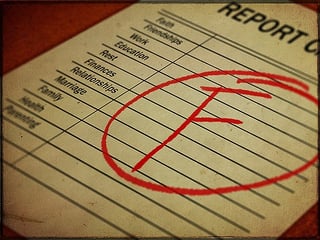
amboo who?/Flickr
SAT Example

Placing a comma after “added” is incorrect because it interrupts the thought before it is complete, which adds confusion about the sentence’s purpose. “Specifically, an extra “leap second” (the 86,401st second of the day) is,” just doesn’t make much sense. Answer choice D is correct because placing any punctuation after “added” would completely disrupt the thought before it can be expressed.
#5: Don’t Use a Comma Between an Adjective and a Noun
You can’t place a comma between an adjective and noun. Check out this example sentence:
Incorrect: Trista bought a blue, truck.
Correct: Trista bought a blue truck.
On the SAT, this comma rule tends to come up when a title is being used as an adjective before a noun. Here are a couple of examples:
Incorrect: I enjoy reading the books of acclaimed writer, Malcolm Gladwell.
Correct: I enjoy reading the books of acclaimed writer Malcolm Gladwell.
Many people incorrectly assume there should be a comma; however, in this sentence, “writer” is describing Malcolm Gladwell, and you can’t place a comma between an adjective and a noun.
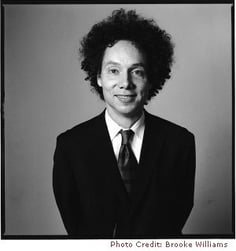
I like his books. (Michelle Tribe/Flickr)
Similarly, if the title comes before a possessive noun, there shouldn’t be a comma after the title or the possessive. Check out this example:
Incorrect: You are extremely excited to read PrepScholar writer, Justin Berkman’s next article.
Incorrect: You are extremely excited to read PrepScholar writer Justin Berkman’s, next article.
Correct: You are extremely excited to read PrepScholar writer Justin Berkman’s next article.
SAT Example

Remember: if a title is being used as an adjective to introduce a noun, there shouldn’t be a comma separating the two. In this example, “critic” is a title serving as an adjective, and “Stina Chyn” is the noun of the sentence taking this title. Answer choices A and B are both incorrect because they place a comma directly after the title/adjective, splitting up the title/adjective and the noun it belongs to. Answer choice C is correct because it allows the noun and its adjective (critic Stina Chyn) to be introduced completely without any interruption.
Semicolons on the SAT
The only thing you have to know about semicolons is that they are used to separate two complete thoughts. You should be able to replace the semicolon with a period and have two complete sentences. Here’s an example:
Incorrect: Because Jesse is my friend; I invited him to my party.
Correct: Jesse is my friend; I invited him to my party.
The second sentence is correct because the semicolon is separating two independent clauses. On the SAT, semicolons are often used incorrectly.

SAT Example

Immediately, we know that the semicolon is correct because both the clause before and the clause after the semicolon can stand alone as complete sentences. So, answer choice C is correct.
Colons on the SAT
Unlike semicolons, which can only separate independent clauses, colons can be used to separate independent clauses or connect an independent and a dependent clause.
Whether they’re connecting two independent clauses or an independent and a dependent clause, though, colons must always be placed after a complete sentence (an independent clause). You should be able to put a period in place of the colon and have that first sentence (before the colon) make sense.
Colons are commonly used in this way to introduce lists and explanations.
Incorrect: Jasmine brought everything she needed for the exam, including: pencils, a backpack, and a calculator.
Correct: Jasmine brought everything she needed for the exam: pencils, a backpack, and a calculator.
The first sentence is incorrect because the part that comes before the colon isn’t a complete thought.
Also, a colon should be used instead of a comma to separate a noun from items on a list:
Incorrect: Lewis was excited to meet his relatives, his aunt, uncle, and cousins from the Bahamas.
Correct: Lewis was excited to meet his relatives: his aunt, uncle, and cousins from the Bahamas.
The first sentence makes it seem like “his relatives” is part of the list. However, all of the people he is meeting are his relatives, and the portion after the colon lists the relatives whom he will be meeting.
Additionally, colons can be used to provide explanations. Here’s an example:
Sandy repeatedly complained about her least favorite restaurants: places where you can often hear loud conversations and crying babies.

In the above sentence, the colon is placed after a complete thought, and the portion of the sentence after the colon describes the type of restaurants that Sandy dislikes. You could substitute the colon with a comma, but you need punctuation to separate the complete thought from the explanatory phrase.
SAT Example
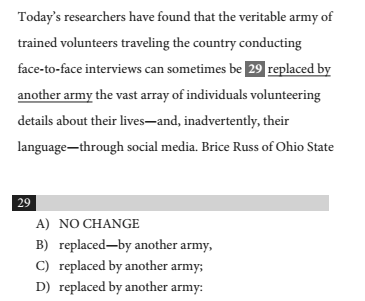
The portion of the sentence after “army” describes the other type of army. We need punctuation to separate the complete thought up until “army” from the phrase elaborating on this group of people. Answer choice C is incorrect because the phrase following “army” isn’t a complete thought, and answer choice B is wrong because the dash before “by” is unnecessary (I’ll explain dashes next). The correct answer is D.
Dashes on the SAT
Dashes aren’t very common on the SAT, but they do come up. They can be used to mark off a non-essential clause or phrase (like a comma) or introduce a list or explanation (like a colon).
If dashes are used with non-essential clauses or phrases, you can’t mix them with commas. You have to go with either two dashes or two commas. Here’s an example:
Incorrect: Ryan, an energetic teenager—can’t sit still during class.
Correct: Ryan—an energetic teenager—can’t sit still during class.
Correct: Ryan, an energetic teenager, can’t sit still during class.
This is an example using a dash like a colon to set up an explanation:
Correct: Ryan can’t sit still during class—he’s an energetic teenager.
Lastly, a dash can be used for stylistic reasons to interrupt a statement or create a dramatic pause. Check out this example:
Byron spent hours painting a beautiful picture—and then his little brother destroyed it.
You don’t have to worry too much about using dashes for this type of sentence. If a dash is the correct answer in a similar sentence, then you’ll be able to eliminate the other answer choices because they’ll be obviously incorrect.
SAT Example

The phrase from “ocean dwellers” to “cuttlefish” is a non-essential phrase. You can get rid of the phrase without altering the meaning of the sentence. It’s included here to add more detail about cephalopods, but the information inside of the dashes isn’t required to understand the main idea of the sentence.
Using dashes instead of commas in this example works especially well because there is already a list (separated by commas) within the non-essential phrase: “the squid, the octopus, and the cuttlefish.” Therefore, using dashes instead of even more commas to set off this non-essential phrase works nicely, and so the correct answer is C.
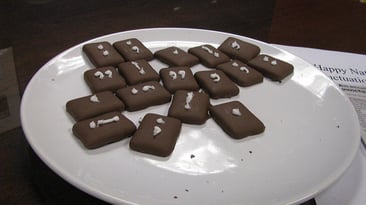
Punctuation cookies! (David Erickson/Flickr)
The Most Important Rules and Strategies for SAT Punctuation
Because we’ve gone over a number of punctuation rules and ways to correct punctuation errors, I’m going to sum up the most important points to help you correctly answer SAT Writing punctuation questions.
Important Rules
- Surround appositives and non-essential phrases with commas.
- Use commas to separate items in a list.
- Don’t use commas in between two independent clauses.
- Semicolons connect two independent clauses.
- Colons come after a complete sentence and set up a list or explanation.
- Dashes can be used to mark off non-essential clauses or introduce lists and explanations.
Strategies
- Leave out punctuation unless you identify a situation that requires it.
- You’ll never be asked to choose between interchangeable punctuation marks: if two answer choices serve the same function, then both will be wrong.
- Use process of elimination to determine the right answer on punctuation questions. Many of the wrong answers will have errors that you’ll be quickly able to detect. Eliminating the wrong answers can sometimes be easier than choosing the right one.
Practice Questions
Try these practice questions using the knowledge you've acquired.
- Studies show that children; who are physically active may perform better in the classroom.
- Last week, Theodore—who is an extremely conscientious student, won a $10,000 scholarship; his parents are incredibly proud.
- Julie was thoroughly confused she couldn’t figure out where she put her car keys.
- Paul was overcome with joy when he saw actor, Keanu Reeves, in the parking lot of a McDonald’s restaurant.
- I hurried home from school to find Max, my dog that I’ve had for five years chewing on my favorite pair of shoes.
Answers: 1. C, 2. B, 3. A, 4. D, 5. C
What's Next?
If you thought punctuation wasn't tested on the SAT because you're only familiar with the old SAT, read this article to find out how the SAT Reading and Writing section has changed.
Also, make sure you know and understand the most important grammar rules for SAT Writing.
Finally, as you're preparing for the SAT, learn the pros and cons of different prep methods.





